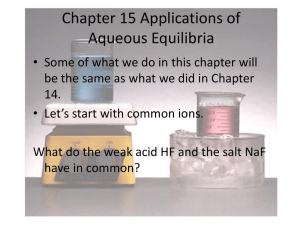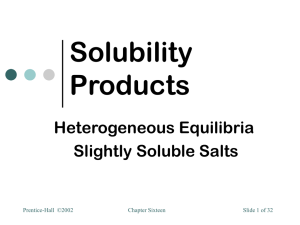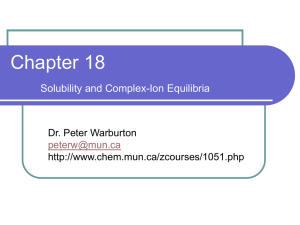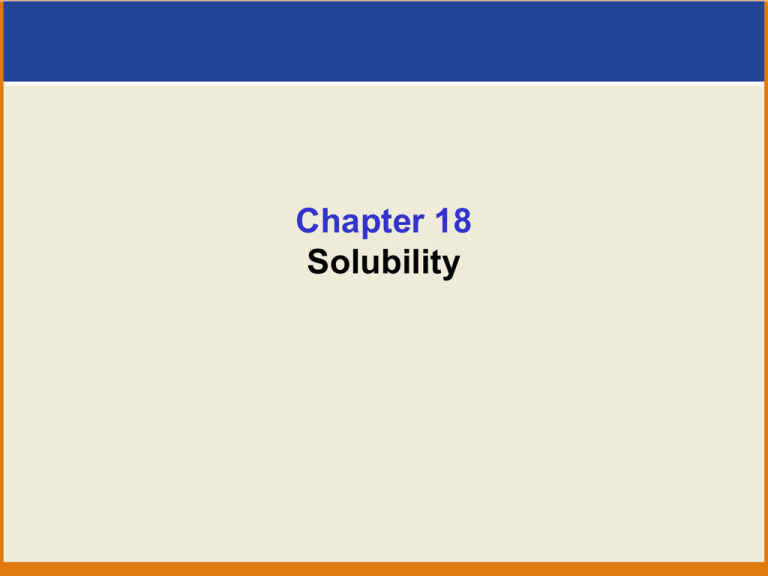
Chapter 18
Solubility
Equilibria of Slightly Soluble Ionic Compounds
• Explore the aqueous equilibria of slightly
soluble ionic compounds.
• Chapter 5. Precipitation Reactions:
AgNO3(aq) + NaCl(aq) ??
• Want to consider quantitative predictions
The Formation & Dissolution of Precipitates
• Solubility: maximum amount of solute that will dissolve in a given
amount of solvent (depends on solvent, temperature and pressure)
No compound is infinitely soluble and
no compound is perfectly insoluble.
Solute Solubility
(g solute/100 g solvent)
Qualitative Solubility
Description
Less than 0.1
Insoluble
0.1 – 1
Slightly soluble
1 – 10
Soluble
Greater than 10
Very soluble
The Formation & Dissolution of Precipitates
• Saturated solution: contains maximum
concentration of solute
– Equilibrium between undissolved and dissolved solute.
• Solutes (even those called “soluble”) have a limited
solubility in a particular solvent.
• Slightly soluble (often called “insoluble”) ionic
compounds have a relatively low solubility
– Reach equilibrium with little solute dissolved
– Heterogeneous equilibrium
Why is this important?
Dissolving and Precipitation occurs around us:
– Tooth enamel dissolves in acidic soln (tooth decay)
– Ppt of certain salts in kidneys causes kidney stones
– Waters of Earth contains dissolved salts as water
passes over and through the ground
– Ppt of CaCO3 from groundwater is responsible for
cave formation.
Let’s look at the factors that affect solubility!
Solubility-Product Constant (Ksp)
• Solubility-product constant (Ksp): equilibrium constant
for equilibrium between slightly soluble ionic solid and a
solution of its ions
– Indicates how soluble the solid is in water
• Solubility: quantity that dissolves to form a saturated
solution (g/L)
• Molar solubility: number of moles of solute that
dissolves in forming a liter of saturated solution of solute
(mol/L)
• Solubility depends on concentrations of other ions and
pH but Ksp is a constant.
Solubility-Product Constant (Ksp)
Practice: Write an ionic equation for the dissolution,
and the equation for the solubility product for:
(a) Calcium carbonate
(b) Magnesium hydroxide
(c) Ag3PO4
•
Magnitude of Ksp is measure of how far to the right
dissolution proceeds at equilibrium (saturation).
–
Used to compare solubilities if same total number of ions
Ksp of Selected Ionic Compounds (25 °C)
Name, Formula
Aluminum hydroxide, Al(OH)3
Ksp
3 x 10-34
Cobalt(II) carbonate, CoCO3
1.0 x 10-10
Iron(II) hydroxide, Fe(OH)2
4.1 x 10-15
Lead(II) fluoride, PbF2
Lead(II) sulfate, PbSO4
Mercury(I) iodide, Hg2I2
3.6 x 10-8
1.6 x 10-8
4.7 x 10-29
Silver sulfide, Ag2S
8 x 10-48
Zinc iodate, Zn(IO3)2
3.9 x 10-6
See Appendix D in your book for a much more extensive list.
Example
Predict which of the following compounds will
have the greatest molar solubility in water
A) AgCl
Ksp = 1.8 x 10-10
B) AgBr
Ksp = 5.0 x 10-13
C) AgI
Ksp = 8.3 x 10-17
D) all have the same molar solubility
Solubilities and Solubility Products
• Ksp for a slightly soluble solid can be determined
from its solubility
– as long as there is no other reaction
• Example 1: Lead(II) sulfate (PbSO4) is a key
component in lead-acid car batteries. Its solubility in
water at 25 °C is 4.25 x 10-3 g/100 mL solution. What
is the Ksp of PbSO4?
• Example 2: Determine the molar solubility of MgF2
from its solubility product (Ksp = 6.4 x 10-9).
Example
Calculate the molar solubility of calcium
fluoride, CaF2
Ksp = 3.7 x 10-11
Factors that Affect Solubility: Common Ion Effect
•The presence of a common ion decreases the
solubility of a slightly soluble ionic compound.
•The shift in equilibrium that occurs because of
the addition of an ion already involved in the
equilibrium reaction.
AgCl(s) ⇌ Ag+(aq) + Cl-(aq)
adding
NaCl( aq ) shifts equilibrium position
The effect of a common ion on solubility
CrO42- added
PbCrO4(s)
Pb2+(aq) + CrO42-(aq)
PbCrO4(s)
Pb2+(aq) + CrO42-(aq)
Example
The solubility of Ca(OH)2 in water is 0.012 M.
What is its solubility in 0.10 M Ca(NO3)2?
Ksp of Ca(OH)2 is 6.5 x 10-6
Le Châtelier’s Principle
Determine the effects of solubility when each of
the following is added to a mixture of the
slightly soluble solid NiCO3 and water at
equilibrium:
(a)Ni(NO3)2
(c) K2CO3
(b)KClO4
(d) HNO3
Effect of pH on solubility
• [H3O+] can have a profound effect on the solubility of
an ionic compound.
• Solubility of slightly soluble salts containing basic
anions increases as [H+] increases
– More basic anion…more solubility is influenced by pH
• Predict the effect on solubility of adding a strong acid
CaCO3(s) ⇌ Ca2+(aq) + CO32-(aq)
AgCl(s) ⇌ Ag+(aq) + Cl-(aq)
Ca(OH)2(s) ⇌ Ca2+(aq) + 2OH-(aq)
If limestone (CaCO3) deposit is near surface…sinkhole
If limestone (CaCO3) deposit is well below the surface….caves
A view inside Carlsbad Caverns, New Mexico
Cango Caves
Copyright © Houghton Mifflin Company.All rights reserved.
1–19
Sudwala Caves
Copyright © Houghton Mifflin Company.All rights reserved.
1–20
Example
Calculate the molar solubility of MgF2 in 0.10 M
MgCl2 at 25 C.
Ksp of MgF2 = 7.4 x 10-11
Predicting the Formation of a Precipitate
Compare Qsp to Ksp to predict if a precipitate will form
and, if not, what concentrations of ions will cause it to
do so.
Qsp = Ksp
Qsp > Ksp
Qsp < Ksp
soln is saturated & no changes occur
ppt forms until soln is saturated
soln is unsaturated & no ppt forms
Practice
• Example 1: Determine whether CaHPO4 will
precipitate from a solution with [Ca2+] =
0.0001 M and [HPO42-] = 0.001 M.
• Example 2: Does silver chloride precipitate
when equal volumes of a 2 x 10-4 M solution of
AgNO3 and a 2 x 10-4 M solution of NaCl are
mixed.
AgNO3(aq) + NaCl(aq) AgCl(s) + NaNO3(aq)
Practice
Will a precipitate form when 0.10 L of
8.0 x 10-3 M Pb(NO3)2 is added to 0.40 L of
5.0 x 10-3 M Na2SO4?
Ksp for PbSO4 = 6.3 x 10-7
Concentration Necessary to Form a Ppt
• We can also determine the concentration of an ion
necessary for precipitation to begin.
• Assume that precipitation begins when Qsp = Ksp
• Example: If a solution contains 0.0020 mol CrO42per liter, what concentration of Ag+ ion must be added
as AgNO3 before Ag2CrO4 begins to precipitate.
(Neglect any increase in volume upon adding the
solid silver nitrate.)



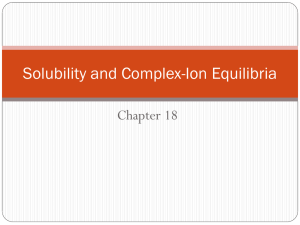
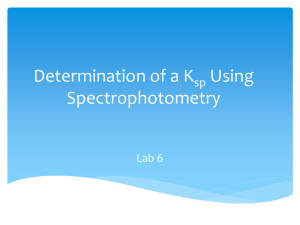
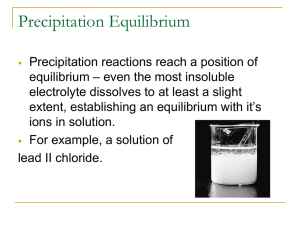


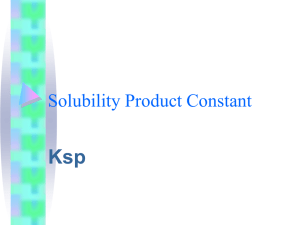
![K sp = [Pb 2+ (aq)][Cl](http://s2.studylib.net/store/data/005788724_1-fd79e2539544b4374a3f7aa03b8a844b-300x300.png)
